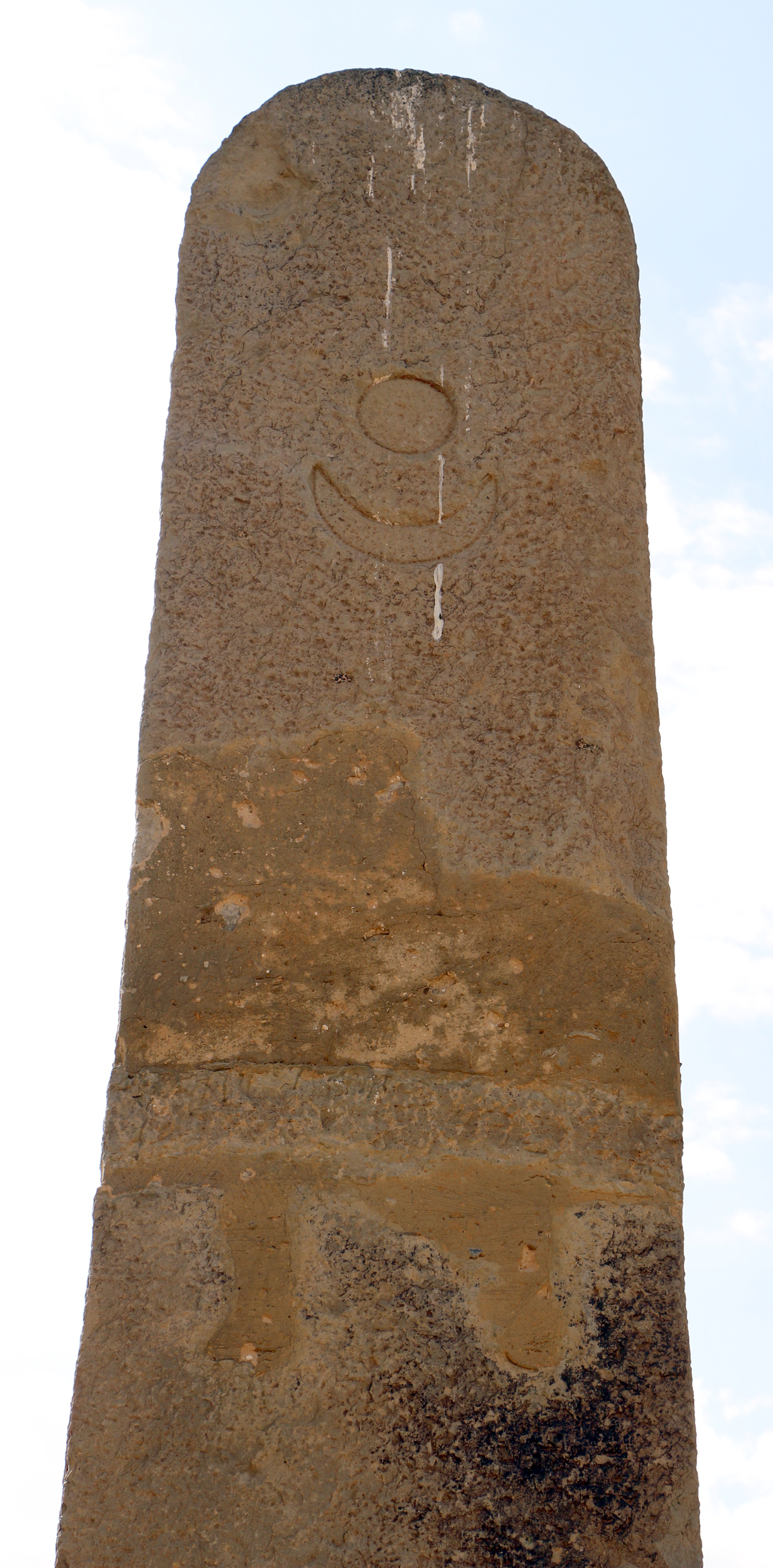Hawulti (monument) on:
[Wikipedia]
[Google]
[Amazon]
Hawulti () is a pre-Aksumite
 The Hawulti monument is high, with a disk and crescent at the top; Ullendorff believes these symbols "no doubt meant to place the stele under the protection of the gods, probably of Šams, the Sun goddess, and of
The Hawulti monument is high, with a disk and crescent at the top; Ullendorff believes these symbols "no doubt meant to place the stele under the protection of the gods, probably of Šams, the Sun goddess, and of
The HawultiAFP: Eritrea rebuilds country's symbolic stone pillar
6th-century BC inscriptions History of Eritrea History of Ethiopia Axumite obelisks Monuments and memorials in Eritrea Archaeology of Eastern Africa
obelisk
An obelisk (; from grc, ὀβελίσκος ; diminutive of ''obelos'', " spit, nail, pointed pillar") is a tall, four-sided, narrow tapering monument which ends in a pyramid-like shape or pyramidion at the top. Originally constructed by An ...
located in Matara, Eritrea. The monument
A monument is a type of structure that was explicitly created to commemorate a person or event, or which has become relevant to a social group as a part of their remembrance of historic times or cultural heritage, due to its artistic, hist ...
bears the oldest known example of the ancient Ge'ez script.
Description
Sin
In a religious context, sin is a transgression against divine law. Each culture has its own interpretation of what it means to commit a sin. While sins are generally considered actions, any thought, word, or act considered immoral, selfish, s ...
, the Moon god". These pre- Christian symbols, as well as paleographical characteristics such as the lack of vowel marks in the Ge'ez script, convinced Ullendorff that the monument dated "to the early part of the fourth century A.D."
Ullendorff translated of the inscription as follows:
: This is the obelisk which had made
: 'Agaz for his fathers who have
: carried off the youth of ‘W’
: ‘LF as well as of SBL.
His translation differs from Enno Littmann at several points. First, Littmann believed the third line referred to the digging of canals nearby (his translation, "zog die Kannaele von `Aw`a") despite the lack of any signs of canals or ditches in the area; Ullendorff argues that the verb ''s-h-b'' in the inscription should be translated as "to drag along, to capture". Second, he believed the nouns — ''‘W’'', ''‘LF'', and ''SBL'' — were placenames, and based on discussions with local informants Ullendorff identified them with nearby communities: the earlier name of Baraknaha, the site of a 12th-century church
Church may refer to:
Religion
* Church (building), a building for Christian religious activities
* Church (congregation), a local congregation of a Christian denomination
* Church service, a formalized period of Christian communal worship
* C ...
17 kilometers from Matara, had been ''subli'', and the equally well-known Orthodox
Orthodox, Orthodoxy, or Orthodoxism may refer to:
Religion
* Orthodoxy, adherence to accepted norms, more specifically adherence to creeds, especially within Christianity and Judaism, but also less commonly in non-Abrahamic religions like Neo-pa ...
church at Gunda Gunde
Gunda Gunde Monastery ( ti, ገዳም ጉንዳ ጉንዶ ''Gädam gunida gunido'') is an Ethiopian Orthodox Tewahedo monastery located to the south of Adigrat in the Misraqawi (Eastern) Zone of the northern Tigray Region in Ethiopia. It is known ...
, 22 kilometers from Matara, had once been known as ''Aw`a 'ilfi''.
Modern history
When Littmann, leader of the Deutsche Aksum-Expedition, found the Hawulti, it had been pushed over and broken in half in the distant past. The Italian colonial government had the broken monument repaired with two iron bars and set upright in what thought to be its proper location, but its exact original location is not known for sure. The Hawulti was toppled and damaged by Ethiopian troops in the short occupation of southern Eritrea during the Eritrean-Ethiopian War. It has since been repaired by theNational Museum of Eritrea
The National Museum of Eritrea is a national museum in Asmara, Eritrea. Established in 1992 by Woldeab Woldemariam, it was originally located in the former Governor's Palace until 1997, when it was moved. The venue has since been relocated to ...
.{{cite web, url=http://www.dehai.org/archives/dehai_news_archive/apr-may05/0791.html, title=Ancient statue at Belew Kelew repaired, accessdate=2006-09-10, date=2005-05-14, url-status=dead, archiveurl=https://archive.today/20070527140205/http://www.dehai.org/archives/dehai_news_archive/apr-may05/0791.html, archivedate=2007-05-27
See also
*Ezana Stone
The Ezana Stone is an ancient stele still standing in modern day Axum in Ethiopia, the centre of the ancient Kingdom of Aksum. This stone monument, that probably dates from the 4th century of the Christian era, documents the conversion of King Ez ...
*King Ezana's Stela
King Ezana's Stele is a 4th century obelisk in the ancient city of Axum, in the Tigray Region of Ethiopia. The monument stands in the middle of the Northern Stelae Park, which contains hundreds of smaller and less decorated stelae. This stele is ...
*Monolithic architecture
Monolithic architecture describes buildings which are carved, cast or excavated from a single piece of material, historically from rock. The most basic form of monolithic architecture is a rock-cut building, such as the monolithic churches of Et ...
*Yeha
Yeha ( gez, ይሐ ''yiḥa'', older ESA 𐩥𐩢 ''ḤW''; Old South Arabian: 𐩺𐩢𐩱 ''Yḥʾ'') is a town in the Maekelay Zone of the northern Tigray Region in Ethiopia. It likely served as the capital of the pre-Aksumite kingdom of D'm ...
References
External links
The Hawulti
6th-century BC inscriptions History of Eritrea History of Ethiopia Axumite obelisks Monuments and memorials in Eritrea Archaeology of Eastern Africa